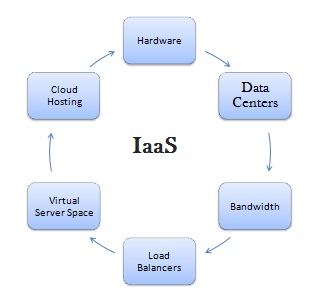Infrastructure as a Service (IaaS) Definition

Infrastructure as a service (IaaS) is a form of cloud computing that provides virtualized computing resources over the internet. IaaS is one of the three main categories of cloud computing services, alongside software as a service (SaaS) and platform as a service (PaaS).
IaaS architecture and how it works
In an IaaS model, a cloud provider hosts the infrastructure components traditionally present in an on-premises data center, including servers, storage and networking hardware, as well as the virtualization or hypervisor layer.
The IaaS provider also supplies a range of services to accompany those infrastructure components. These can include detailed billing, monitoring, log access, security, load balancing and clustering, as well as storage resiliency, such as backup, replication and recovery. These services are increasingly policy-driven, enabling IaaS users to implement greater levels of automation and orchestration for important infrastructure tasks. For example, a user can implement policies to drive load balancing to maintain application availability and performance.
IaaS customers access resources and services through a wide area network (WAN), such as the internet, and can use the cloud provider’s services to install the remaining elements of an application stack. For example, the user can log in to the IaaS platform to create virtual machines (VMs); install operating systems in each VM; deploy middleware, such as databases; create storage buckets for workloads and backups; and install the enterprise workload into that VM. Customers can then use the provider’s services to track costs, monitor performance, balance network traffic, troubleshoot application issues, manage disaster recovery and more.
Any cloud computing model requires the participation of a provider. The provider is often a third-party organization that specializes in selling IaaS. Amazon Web Services (AWS) and Google Cloud Platform (GCP) are examples of independent IaaS providers. A business might also opt to deploy a private cloud, becoming its own provider of infrastructure services.
IaaS pros and cons
Organizations choose IaaS because it is often easier, faster and more cost-efficient to operate a workload without having to buy, manage and support the underlying infrastructure. With IaaS, a business can simply rent or lease that infrastructure from another business.
IaaS is an effective model for workloads that are temporary, experimental or that change unexpectedly. For example, if a business is developing a new software product, it might be more cost-effective to host and test the application using an IaaS provider. Once the new software is tested and refined, the business can remove it from the IaaS environment for a more traditional, in-house deployment. Conversely, the business could commit that piece of software to a long-term IaaS deployment, where the costs of a long-term commitment may be less.
In general, IaaS customers pay on a per use basis, typically by the hour, week or month. Some IaaS providers also charge customers based on the amount of virtual machine space they use. This pay-as-you-go model eliminates the capital expense of deploying in-house hardware and software.
When a business cannot use third-party providers, a private cloud built on premises can still offer the control and scalability of IaaS — though the cost benefits no longer apply.
Enterprises’ infrastructure management responsibilities change, depending on whether they choose an on-premises, IaaS, PaaS or SaaS deployment.
IaaS vs. SaaS vs. PaaS
IaaS is only one of several cloud computing models, and it is complemented by alternative models that include PaaS and SaaS.
PaaS builds on the IaaS model because, in addition to the underlying infrastructure components, providers host, manage and offer operating systems, middleware and other runtimes for cloud users. While PaaS simplifies workload deployment, it also restricts a business’s flexibility to create the environment that they want.
With SaaS, providers host, manage and offer the entire infrastructure, as well as applications, for users. A SaaS user does not need to install anything; he or she simply logs in and uses the provider’s application, which runs on the provider’s infrastructure. Users have some ability to configure the way that the application works and which users are authorized to use it, but the SaaS provider is responsible for everything else.
Major IaaS vendors and products
There are many examples of IaaS vendors and products. AWS offers storage services such as Simple Storage Services (S3) and Glacier, as well as compute services, including its Elastic Compute Cloud (EC2). GCP offers storage and compute services through Google Compute Engine (GCE), as does Microsoft Azure.
These are just a tiny sample of the broad range of services offered by major IaaS providers. Services can include serverless functions, such as AWS Lambda, Azure Functions or Google Cloud Functions; database access; big data compute environments; monitoring; logging; and more.
There are also many other smaller, or more niche players in the IaaS marketplace, including Rackspace Managed Cloud, CenturyLink Cloud, DigitalOcean and more.
Users will need to carefully consider the services, reliability and costs before choosing a provider — and be ready to select an alternate provider and to redeploy to the alternate infrastructure if necessary.